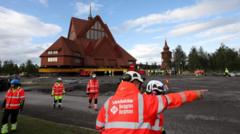A striking landmark in the northern Swedish city of Kiruna is undertaking a historic relocation, as the magnificent 113-year-old church begins an extraordinary two-day journey to a new home. At risk of subsidence due to extensive iron ore mining operations, this beloved red timber structure is being carefully transported 5 kilometers (3 miles) along the road.
The relocation commenced early Tuesday morning, as the church - which stands 35 meters (115 feet) tall and weighs 672 tonnes - was hoisted onto giant rolling platforms designed for such complex moves. Travelling at a pace of up to 500 meters an hour, the journey is anticipated to take approximately two days, highlighting an engineering achievement while radiating profound emotional significance for the local residents.
The urgency of this significant move is underscored by mining-related ground fissures threatening the old city center, increasing the risk of infrastructure failure, including vital water, electricity, and sewage systems. As Robert Ylitalo, CEO of Kiruna's development company, explained, the relocation is deemed necessary to ensure community safety, especially as LKAB, the mine's operator and Kiruna's largest employer, foots the $1 billion (10 billion Swedish krona) bill for this ambitious project.
Over the years, Kiruna has seen several of its buildings gently moved to safe ground, with some landmark structures successfully relocated intact. Unlike most buildings that were demolished and rebuilt, the church's relocation retains its historical integrity and richness. Instead of disassembling this grand structure, engineers designed a plan for its transportation in one piece, relying on steel beams and self-propelled modular transporters.
Project manager Stefan Holmblad Johansson articulated the challenges faced during this endeavor. "Preparing the road for such a broad building was a significant task," he noted, reflecting on the adjustments made, including road widening and removing obstacles like street lights. Meanwhile, the church's historical treasures, particularly a critical altar painting, were secured within the building, ensuring their preservation throughout the move.
As a spiritual heart for the community, the church represents collective memories and experiences for Kiruna's residents. Sofia Lagerlöf Määttä described it as a place filled with joy and sorrow, emphasizing the emotional weight carried with this community relic as it transitions to a new setting.
For Vicar Lena Tjärnberg, the moment of relocation is bittersweet. She expressed gratitude for the church's move but also acknowledged the sorrow of leaving its original ground. As the walls of Kiruna's church start their slow journey forward, residents and spectators, including Sweden's King Carl XVI Gustaf, are expected to line the route. The move will be further immortalized through live broadcasts, allowing a piece of Kiruna's cherished history to accompany the city as it evolves.






















